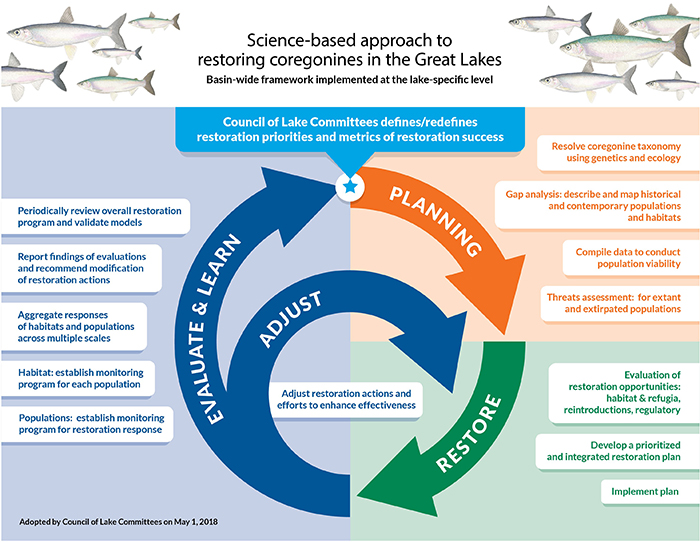Coregonine Fish Restoration
As many as 11 species of coregonines (ciscoes, whitefishes) once occurred in the Great Lakes. A century ago, coregonines were abundant in each lake, occupying diverse habitats- rivers, bays, and the deepest parts of the lakes. Some species were key prey for lake trout and burbot, and supported some of the largest freshwater fisheries ever recorded. Among the coregonines, the species of ciscoes declined dramatically between the 1920s and 1970s, due to overfishing, invasive species, and habitat loss. At least two species are now extinct and several species no longer occur in several lakes. The whitefish species have been more resilient, but have been undergoing their own declines in the past 20 years.
To support diverse fisheries, reestablish lost trophic linkages and improve ecosystem resiliency, the coregonine restoration framework (see image below) was endorsed by the Council of Lake Committees on May 1, 2018. The basin wide framework was based on principles of adaptive management and conservation biology and is designed to be implemented at the lake-specific level (see Bunnell et al. 2023).

The "planning" element of the framework requires implementation of methods that have been reviewed through the joint strategic plan process and is inclusive of both western science and Indigenous Knowledge. The "restore" element in the framework seeks to develop a restoration plan that could include reintroducing extirpated species, restoring or connecting habitats, or using regulatory authorities to create refuges or otherwise limit fishing mortality. The "evaluate and learn" element monitors the effectiveness of the restoration actions and provides fishery managers with the opportunity to modify restoration strategies or priorities.
The GLFC Science program supports the coregonine restoration framework by funding three U.S. Geological Survey scientists that are seeking to increase knowledge capacity throughout the basin and directly support the restoration framework and by supporting coregonine-focused proposals within its annual requests for proposals.
More information about the broader effort to restore and conserve coregonines across the Great Lakes, including information about ongoing efforts in some of the lakes can be found at Coregonine Fish Restoration | (greatlakesciscoes.org).
The GLFC also hosts a monthly Coregonine webinar on the first Friday of each month. The topics are diverse, ranging from ecology and evolution to hatchery rearing practices to monitoring of ongoing restoration efforts. Although many of the topics are Great Lakes based, we have also invited speakers from outside North America, given the circumpolar distribution of coregonines. Contact the science program at research@glfc.org to get on the distribution list to be able to register for the webinars. Many of the webinars are also posted here for later viewing.

